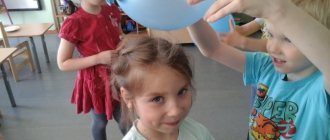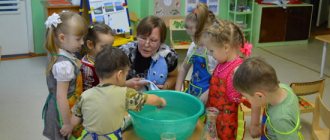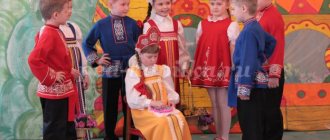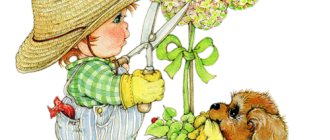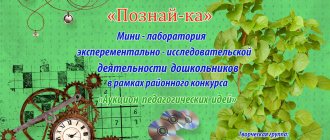Scientific research activities in preschool education
Research activities in preschool educational institutions
Modern children live in the era of informatization and computerization. In a rapidly changing life, a person is required not only to possess knowledge, but also, first of all, to be able to obtain this knowledge himself and operate with it, to think independently and creatively.
A child is born a researcher. An unquenchable thirst for new experiences, curiosity, a constant desire to observe and experiment, to independently seek new information about the world, are traditionally considered as the most important features of children's behavior.
Research and search activity is the natural state of a child; he is determined to master the world around him, he wants to get to know it. This internal desire for research gives rise to exploratory behavior and creates the conditions for the child’s mental development to initially unfold as a process of self-development.
When we talk about cognitive-research activities, we mean the child’s activity directly aimed at understanding the structure of things, the connections between the phenomena of the surrounding world, their ordering and systematization.
This activity originates in early childhood, at first representing a simple, seemingly aimless (processual) experimentation with things, during which perception is differentiated, the simplest categorization of objects by color, shape, purpose arises, sensory standards and simple instrumental actions are mastered.
During the period of preschool childhood, the “island” of cognitive and research activity is accompanied by play and productive activity, intertwined with them in the form of indicative actions, testing the possibilities of any new material.
By the senior preschool age, cognitive-research activity is isolated into a special activity of the child with its own cognitive motives, a conscious intention to understand how things work, learn new things about the world, and streamline one’s ideas about any area of life.
During the period of preschool childhood, the emergence of a primary image of the world occurs due to the cognitive activity of the child, which has its own specifics at each age stage. The development of cognitive interest in various areas of knowledge and activities is one of the components of both the general development of a preschooler and the further success of his education at school. The preschooler's interest in the world around him, the desire to master everything new, is the basis for the formation of this quality. Throughout preschool childhood, along with play activities, cognitive activity, as a process of acquiring knowledge, skills, and abilities, is of great importance in the development of a child’s personality. While learning about the world around him, the baby strives not only to look at an object, but also to touch it with his hands, tongue, smell it, knock it, etc.
Currently, we are witnessing how another effective method of understanding the patterns and phenomena of the surrounding world is being formed in the preschool education system - the method of experimentation, which has long taken a strong place in higher and secondary schools.
All researchers of experimentation highlight the main feature of the cognitive activity of children: the child learns an object in the course of practical activities with it, the practical actions carried out by the child perform a cognitive, orientation-exploratory function, creating conditions in which the content of this object is revealed.
The goal of cognitive development in preschool educational institutions
The purpose of organizing cognitive-research activities in kindergarten is to develop a research type of thinking in preschoolers. This does not mean that the teacher sees future professional researchers, experimenters and scientists in his students; he allows the children to feel the delight of discovery. It is wrong to impart pure information to children. It's right to let them discover the world anew. With the help of visual, acoustic and sensory perception, preschoolers identify the qualities and properties of objects, with the development of analytical skills - they establish cause-and-effect relationships in the surrounding reality, generalize and systematize accumulated knowledge.
Objectives of cognitive development in preschool educational institutions:
development of interest in objects and phenomena of the surrounding world;
the formation of primary ideas about their properties (shape, color, size, structure, sonority, etc.);
development of thinking abilities: analysis, comparison, generalization, classification, orientation in time and space, establishing relationships;
creating positive motivation to independently search for the necessary information;
stimulating and encouraging curiosity and observation;
formation and improvement of skills in working with various tools, development of fine motor skills.
Forms of organizing research activities in preschool educational institutions
To implement the assigned tasks, the teacher works together with the children in various types of classes: studying the world around them, forming elementary mathematical concepts, preparing for literacy, speech, creative, sports and music.
Children also gain new knowledge while walking, observing objects of living and inanimate nature. In younger groups, observations on the territory of the kindergarten are short-term and aimed at obtaining primary information about natural phenomena, representatives of the animal and plant world. Older preschoolers conduct long-term research, observing changes in nature.
Research activities at preschool educational institutions are organized in the following forms:
Collective. The lesson, aimed at developing research activities, is conducted in a group form in compliance with the principles:
accessibility (each student participates in the research process,
structured (the lesson consists of stating the problem, the main part and summing up,
short duration (overfatigue should be avoided, game elements and physical exercises should be introduced into the course of the lesson).
Subgroup. Research work is carried out in subgroups, when conclusions are assumed after a comparative analysis of several research results (in which soil will the seeds sprout - fresh or salty, for example).
Individual. The teacher organizes tasks for the development of research activities on an individual basis if the level of knowledge and skills lags behind the general one in the group (the child has been transferred from a junior group or has not attended kindergarten before, if it is possible to develop a spontaneous interest in learning something.
Methods and techniques
Among the techniques and methods of organizing cognitive and research activities, we will highlight those that are relevant for use in preschool educational institutions:
Heuristic method. Teachers often create problematic situations as a motivating start to the lesson: this creates a feeling of group cohesion in finding a solution, and activates thinking abilities when analyzing the current situation. The development of curiosity, research and speech skills is facilitated by heuristic conversations, which are based on questions and problems. For example, “Why do tree branches have sufficient flexibility in the warm season, but become brittle in cold weather?”, “Why are some species of birds migratory?” Conducting a heuristic conversation requires careful preparation: the teacher determines the main problematic issue in accordance with the level of knowledge of the children, prepares additional leading and clarifying questions, predicts possible answers and reactions to them.
Observation. The perception of objects and processes organized indoors or on the territory of the kindergarten develops the visual and auditory abilities of children. Explorations carried out during walks immerse children in the natural world with all its diversity of sights, colors, sounds and smells. Observation is one of the active practices of scientific research among preschoolers.
Experiences and experiments. Along with play, experimentation is considered the leading activity of preschoolers. By performing elementary experiments on objects (dropping them on the floor, trying to break them, extracting a sound, etc.), kids acquire information about their properties. Children are happy to participate in experiments on familiar substances, deepening their knowledge: they conduct experiments with water in liquid and solid states , with sand, stones, clay, plants. You need to start conducting experiments with children of the younger group, encouraging upon reaching senior preschool age to want to experiment independently. This method of scientific research activities develops observation, activity, independence in children, contributes to the formation of a friendly atmosphere and team cohesion. Project activity. This type of work involves the joint research activity of children and the teacher and, as an option, parents. In achieving the cognitive goal of the project, not only the child’s thinking abilities are used, but also creative skills. The teacher encourages independent construction of the course of observations and experiments, only if necessary directs the actions of the student.
TRIZ technologies. The theory of inventive problem solving (TRIZ) came to pedagogy from the engineering field and is effectively used in working with young children and schoolchildren. The essence of TRIZ technologies is to encourage the child to independently construct an algorithm of actions to solve the problem that has arisen. This method is used outside the educational process: “Is the toy not working? Determine what happened. A wheel breaks, think about how you can fix it. Compare the broken wheel with those that are in good working order.” In kindergarten, TRIZ technologies are most often implemented in the form of game tasks: “Oh, our doll Masha the Confused One has lost her cup, how can she drink juice now? And now the doll can’t find an umbrella, how can she get to her grandmother in rainy weather?” This method of work contributes to the development of an analytical type of thinking.
The connection between children's experimentation and other activities
Children's experimentation is not an activity isolated from others. Experimentation permeates all areas of children's activity: eating, playing, studying, walking, sleeping. It is closely connected with all types of activities and primarily with such as observation and work. Observation is an indispensable component of any experiment, since with its help the perception of the progress of work and its results is carried out. But the observation itself can occur without experiment. For example, observing the spring awakening of nature is not associated with an experiment, since the process develops without human participation.
A similar relationship arises between experiment and labor. Labor (for example, service work) may not be associated with experimentation, but there is no experimentation without performing labor actions.
These connections are two-way. On the one hand, the presence of labor and observation skills in children creates favorable conditions for experimentation; on the other hand, experimentation, especially one that arouses great interest in the child, contributes to the development of observation and the formation of labor skills.
Experimentation and speech development are very closely related. This can be clearly seen at all stages of the experiment: when formulating a goal, during a discussion of the methodology and progress of the experiment, when summing up and verbally speaking about what was seen, the ability to clearly express one’s thoughts (i.e., sufficiently developed speech) facilitates the experiment, while How the addition of knowledge contributes to the development of speech. S. L. Rubinstein (1989) and A. M. Leushina showed that the perfection of coherent forms of speech directly depends on the wealth of knowledge. On this occasion, R.K. Aralbaeva and N.K. Kogutenko (1990) write: “. The situation requires that the development of a preschool child’s vocabulary be based on the development of cognitive activity, the deepening of ideas, and the formation of elements of conceptual thinking.” Consequently, without replenishing knowledge, the development of speech would be reduced to simple manipulation of words. This idea was very succinctly expressed by the Kazakh national poet Shakerim Kudaiberdiev: “If you have knowledge, then honor your word.”
Thus, children, when they try to more accurately set the goal of an experiment, begin to reason during discussions of actions. They try to formulate hypotheses. Children develop dialogical speech. They learn to work together, give in to each other, defend their rightness or admit that their neighbor is right.
The connection between children's experimentation and visual activity is also two-way. The more developed a child’s visual abilities are, the more accurately the result of a natural history experiment will be recorded. At the same time, the deeper the performer studies the object in the process of becoming familiar with nature, the more accurately he will convey its details during visual activity. For both types of activity, the development of observation and the ability to register what is seen are equally important.
There is also a connection between experimentation and the formation of elementary mathematical concepts. During experiments, the need constantly arises to count, measure, compare, determine shape and size, etc. All this gives mathematical concepts real significance and contributes to their awareness.
Experimentation is also connected with other types of activities - reading fiction, music and physical education, but these connections are not so pronounced.
Summarizing the limited material on experimentation with preschoolers, we can conclude that experimentation is an effective way of teaching children research activities in all its forms and types and is a method of increasing a child’s independence. Provides the prerequisites for the active development of cognitive interest in the purposeful perception of the surrounding world and is the leading activity in learning.
Conclusion
Today our society needs people who are intellectually independent, who think originally, are creative, and who know how to make non-standard decisions. Throughout preschool childhood, along with play activities, cognitive activity, which is understood as a search process, acquiring knowledge independently or under the tactful guidance of an adult, is of great importance in the development of the child’s personality and in the processes of socialization. Often children are not able to cope with the simplest tasks, but quickly complete it if it is translated into a practical area or into a game. In this regard, the study of children's experimentation is of particular interest.
Children's experimental activities meet the modern requirements of the concept of modernization of Russian education: “...a developing society needs modernly educated, moral, enterprising people who can independently make responsible decisions in a situation of choice, predicting their possible consequences, are capable of cooperation, are different curiosity, dynamism, constructiveness, a developed sense of responsibility for the fate of the country.” Experimental activities of preschoolers are one of the methods of developmental education, aimed at developing independent research skills, promoting the development of creative abilities and logical thinking, combining knowledge acquired during educational activities and introducing them to specific vital problems. It is impossible not to note the positive impact of experiments on the emotional sphere of the child, on the development of creative abilities, the development and enrichment of speech, and the cultivation in children of such qualities as empathy, self-confidence, and sociability. In the process of children's experimentation, the child acts as a subject, independently builds his own activities, and shows activity, which increases noticeably by older preschool age.
The basis of the experimental activities of preschoolers is the thirst for knowledge, the desire for discovery, curiosity, the need for mental impressions, and our task is to satisfy the needs of children, which in turn will lead to intellectual and emotional development.
Publication date:
13.04.2020
Job title:
teacher
Educational institution:
Locality:
Republic of Sakha Yakutia Tomponsky district, Khandyga village
Publication file
Municipal budgetary preschool educational institution Kindergarten "Mishutka"
Report on the topic: “Experimental research activities of children in preschool educational institutions”
Prepared by: Yulia Yurievna Sivak
Tell me and I’ll forget, Show me and I’ll remember, Let me try and I’ll understand” (folk wisdom)
Relevance
Experimentation is one of the types of cognitive activity, any experience, an attempt to accomplish something.
margin-bottom: 0;"> A child is born an explorer. An unquenchable thirst for new experiences, curiosity, a constant desire to observe and experiment, to independently seek new information about the world. Knowledge acquired independently is conscious and more durable. The child learns about an object as a result of practical activities with it.
Honey mushrooms help develop a child’s speech, thinking, logic, and creativity
Research gives the child the opportunity to find answers to the questions of how and why.
Target:
The main goal of experimental activities in kindergarten is the development of the free creative personality of the child.
Experimental activities are aimed at achieving the following objectives
Tasks:
Develop the ability to see the diversity of the world
-Develop observation skills, the ability to compare, analyze, generalize, develop cognitive interest in the process of experimentation
-Develop speech
_Expand the prospects for the development of search and cognitive activity, support children’s initiative and independence
Hypothesis:
If you use experimental experience to develop the cognitive research abilities of preschool children, then the formation of these abilities will happen faster and more efficiently.
In kindergarten, experimentation can be organized in three main directions: specially organized training, joint activities of the teacher with children, and children’s independence.
Experiments help develop a child’s speech, thinking, logic, and creativity
The child must think for himself and learn to draw conclusions. In preschool age, this method is the leading one, and in the first three years it is practically the only way to understand the world. All work is carried out under the supervision of an adult! We always put the health and safety of the child first.
To engage in experimental activities, the group must have an “Experimentation Corner”
The corner should have a variety of materials and instruments for experiments - natural material: stones, tree cuts and leaves, moss, seeds, different types of soil, etc.
-waste material: wire, pieces of leather, fur, fabric, plastic, wood, cork, etc.;
-different types of paper: plain, cardboard, sandpaper, copy paper, etc.
-dyes: food and non-food (gouache, watercolors, etc.
-medical materials: pipettes with rounded ends, flasks, wooden sticks, measuring spoons, rubber bulbs, syringes without needles
-other materials: mirrors, air bullets, butter, flour, salt, sugar and the like; sieve, funnels, halves of soap dishes, magnifying glass, hourglass, microscopes, magnifying glasses, oilcloth aprons, sleeves, rubber gloves, rags
Everything should be accessible and safe for children; the older children become, the more independent they are in preparation for experimentation. It is important to remember that the child hears, sees and does everything himself - he learns and remembers this better.
Children's experimentation has enormous developmental potential. Its main advantage is that it gives children a real idea of the various aspects of the object being studied and its relationships with other objects and the environment. Children's experimentation is closely related to other types of activities - observation, speech development (to be able to clearly express their thought while increasing knowledge contributes to the development of speech).
The most suitable age for starting this type of cognitive activity is the period of 5-6 years. Therefore, it is most effective in older preschool age. He studies everything that happens around him, but most often this happens unsystematically. Specially prepared experiments on experimentation in kindergarten will be able to expand the child’s understanding of the world around him, to interest him in something that he may not encounter in everyday life.
Experimental activities are considered as one of the options for integration. Children are not given knowledge in a ready-made form; they are given the opportunity to reflect, explore, and draw conclusions. With the support of adults, children can become authors of their own creative, as well as research, adventure, gaming, and practice-oriented projects. Participating in the pedagogical process on an equal basis with adults, children design their lives in the space of the kindergarten, showing ingenuity and originality.
Preserving, supporting, developing curiosity, a tendency to experiment - this is the most important task.
Children love to experiment. This is explained by the fact that they are characterized by visual-effective and visual-figurative thinking, and experimentation, like no other method, corresponds to these age-related characteristics. In preschool age, he is the leader, and for the first three years he is practically the only way to understand the world. L. S. Vygotsky repeatedly said: “Experimentation has its roots in the manipulation of objects.”
Children's work is aimed at developing research activities. The main task in the search and research activity of a preschooler is the ability to directly satisfy his inherent curiosity and organize his ideas about the world.
To explore, discover, study means to take a step into the unknown. This is a huge opportunity for children to think, try, search, experiment, and most importantly, express themselves. My task is to help children carry out these studies, to make them demonstrative.
One of the areas of children's experimental activities that I actively use is experiments. I conduct them both during organized activities and in independent ones. Experiments contribute to the development of children's thinking, logic, creativity, and allow them to clearly show the connections between living and nonliving things in nature. Research gave children the opportunity to find answers to the questions “how?” for themselves. and “why?”, provided abundant food for children’s curiosity and are very popular.
Children with great pleasure conduct experiments with paper, fabric, rubber, plastic, sand, and clay. For example, I suggest making a figure from wet and dry sand. Children discuss what kind of sand is being molded and why. Examining sand through a magnifying glass, they find that it consists of small crystals and grains of sand, this explains the flowability of dry sand.
Having lowered the paper into a basin of water, we find out that the paper is soaked and torn; clothes cannot be sewn from paper. Having done experiments with wood and metal, we find out that wood is lighter than metal because it does not sink in water. Conducting experiments with a balloon, we were convinced that the rubber stretches when inflated; by lowering it into a basin of water, we observe that it does not sink, does not let water through, and does not get wet.
Children also enjoy conducting experiments with inanimate objects: sand, clay, magnets, fabrics, snow, water, air. For example, in order to find out if there is air around us, I suggest children catch it using bags, and then determine what color it is? Having filled the bag with air, the children argue that it can be caught, it means that it is around us and that it has no color. This is how I introduce children to the properties of air.
In my research work, I give preference to experiments, experiments, research activities, and independent search activities of children. I see that this type of activity delights children. The experience is fun and exciting, but at the same time, in each experience the reason for the observed phenomenon is revealed, children are led to judgment, conclusion, and in free independent and joint activities.
Such experiments somehow remind the kids of magic tricks, they are unusual, and most importantly, the kids do everything themselves. Our relationships with children are built on the basis of partnership. Children learn to set a goal, solve a problem, put forward hypotheses and test them empirically, and draw conclusions. They experience great joy, surprise and even delight from their small and large discoveries, which give them a feeling of satisfaction from the work done.
Experimental activity is, along with play, the leading activity of a preschool child. The main thing is that the child’s interest in research and discoveries does not fade over time.
I try to involve every child in the process of conducting experiments. Such experiments somehow remind the guys of a magic trick, they are unusual, and most importantly, the guys try to do everything themselves.
Experiments contribute to the formation of children's cognitive interest in objects, develop observation and mental activity. In each experiment, the cause of the observed phenomenon is revealed, children are led to judgments and conclusions.
One of the important points is that when conducting experiments, children become active participants. Children love experiments and actively explore objects, but this requires time and consistency in the presentation of material. When discussing the results of experiments, I lead children to their own conclusions and judgments.
As a result of all the work done with children, I realized that children learn something better if they get involved in the work themselves. Practical contact with life is the method through which children learn about the world and natural phenomena. They become more relaxed and can defend their point of view. This work helps children develop fine motor skills and, for some, overcome shyness and self-doubt.
Together with the guys, we discuss the result that turned out in real life, and I do not try to fit it into ideas that seem correct. In the process of experiments, I note: the child’s memory is enriched, his thought processes are activated, since the need constantly arises to perform operations of analysis, comparison, classification, and generalization. In the course of experimental-cognitive activity, they create situations that the child resolves through experimentation, and by analyzing, draws a conclusion, an inference, independently.
This helps enrich the child’s knowledge, teaches him to analyze, reflect, reflect on what he learns; has a beneficial effect on the child’s worldview and the development of his human and social feelings.
A Chinese proverb says: “Tell me and I will forget, show me and I will remember, let me try and I will understand!”
Games-activities encourage children to independently search for methods of action, to show creativity. Children learn to ask questions: “How to do this?”, make requests: “Let’s do this”, “Let’s see what happens if...”, learn to compare two states the same object and find not only the difference, but also the similarity; They independently conceive the experiment, think through the methodology themselves and distribute responsibilities among themselves, and draw their own conclusions. An entertaining game-activity for preschoolers encourages children to independently search for ways to act and be creative. Such games are aimed at developing in children the ability to isolate essential features of materials and understand the cause and effect relationships between materials and knowledge of objects. An entertaining game-activity for preschoolers encourages children to independently search for ways to act and be creative.
It is important for me that this activity is not set by me in advance in the form of one scheme or another, but is built by the children themselves as they receive new information about the object. Work experience shows that cognitive and research activities in a preschool institution allow not only to maintain existing interest, but also to excite, which for some reason has faded, which is the key to successful learning in the future.
The requirements for experiments vary depending on the nature of the observations.
-no random training required
-planned - begin with choosing an object, setting tasks
The teacher should always encourage children who are looking for their own solutions to a problem, various moves to conduct and complete an experiment, solve a problem, but should not let those children who work slowly out of their sight, they need help, give time.
After the end of the experiment, the children must tidy up their workspace on their own.
In conclusion, I would like to quote the words of K.E. Timiryazeva: “People who have learned... observations and experiments acquire the ability to pose questions themselves and receive factual answers to them at a higher mental and moral level in comparison with those who have not gone through such a school.”
Literature:
Ivanova A.I. Children's experimentation as a teaching method./ Preschool educational institution management, N 4, 2004
Kulikovskaya I.E., Sovgir N.N. Children's experimentation. Senior preschool age. — M.: Pedagogical Society of Russia, 2003
Organization of experimental activities for preschool children. / Under. ed.L.N. Prokhorov M., 2004
Parshukova I.L. Conducting research classes in kindergarten; spatial developmental environment in kindergarten. Principles of construction, advice, recommendations / comp. N.V. Nishcheva. - St. Petersburg, “Childhood-press”, 2006
Solovyova E. How to organize children’s search activities. / Preschool education. N 1, 2005
Materials from Internet sites.
